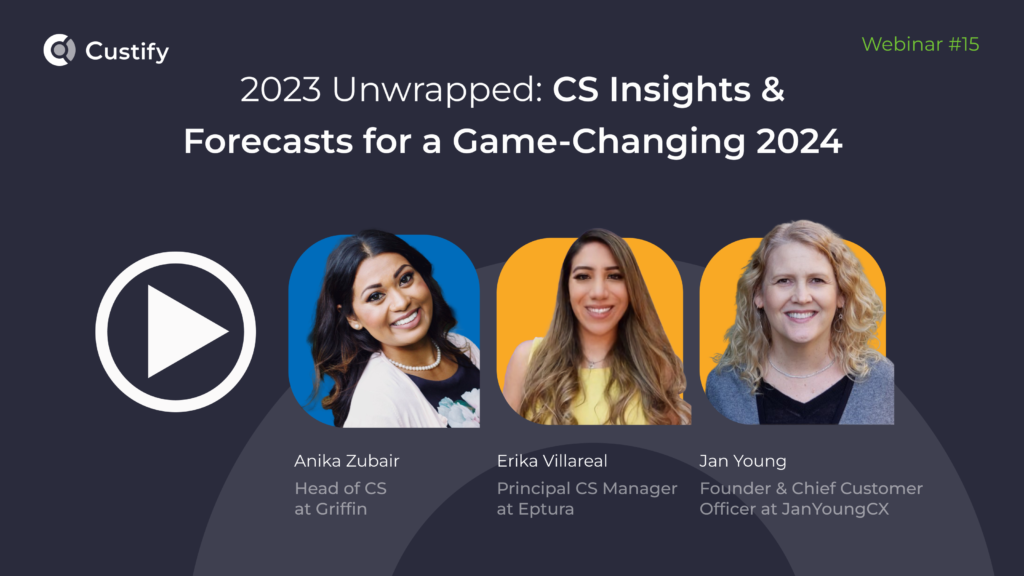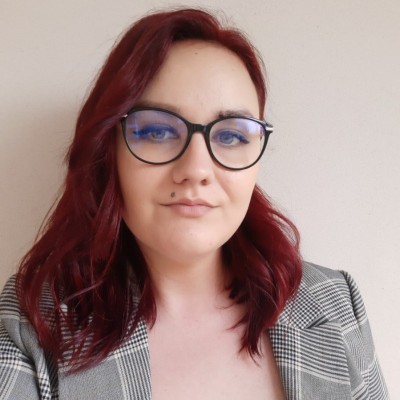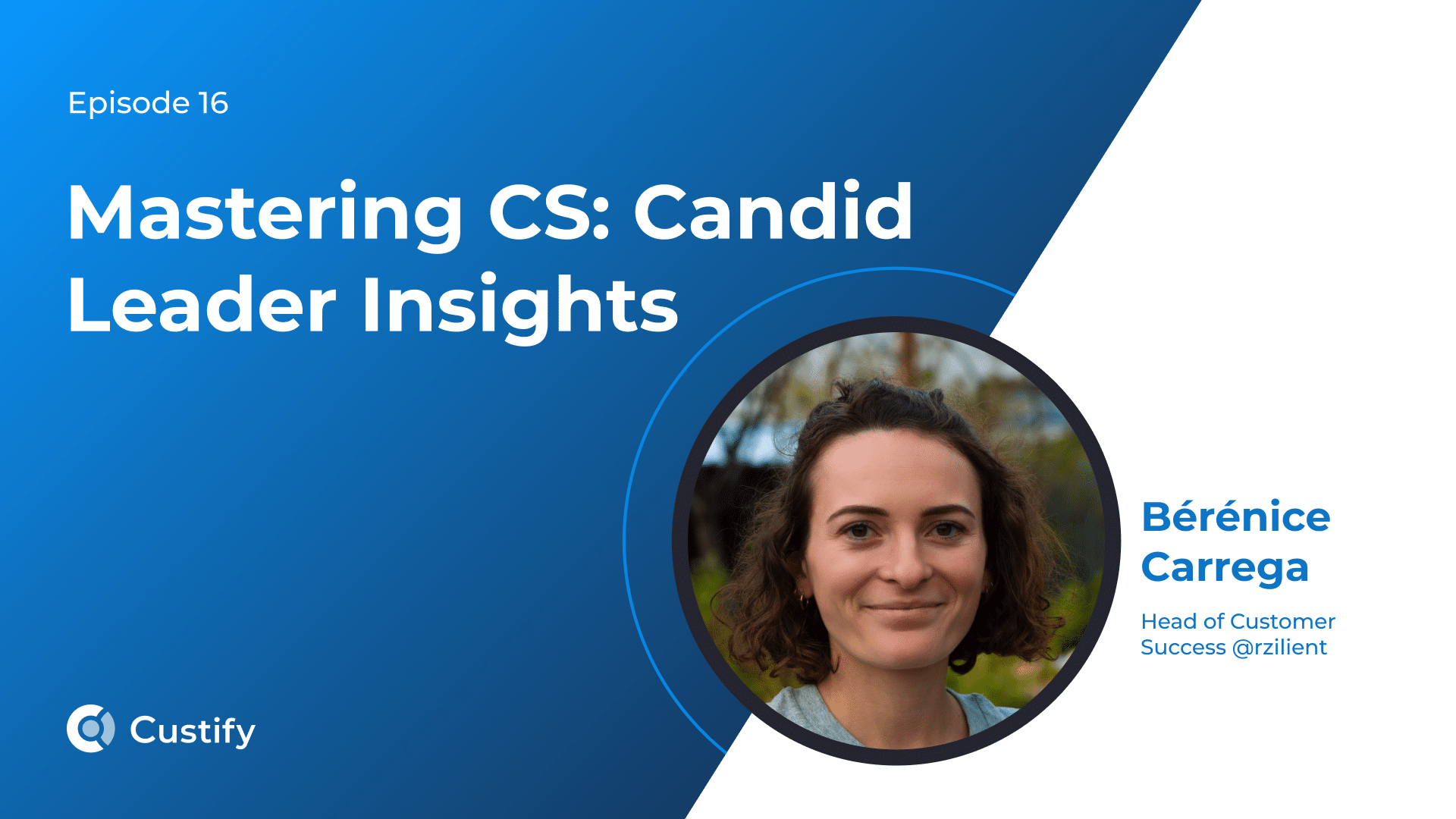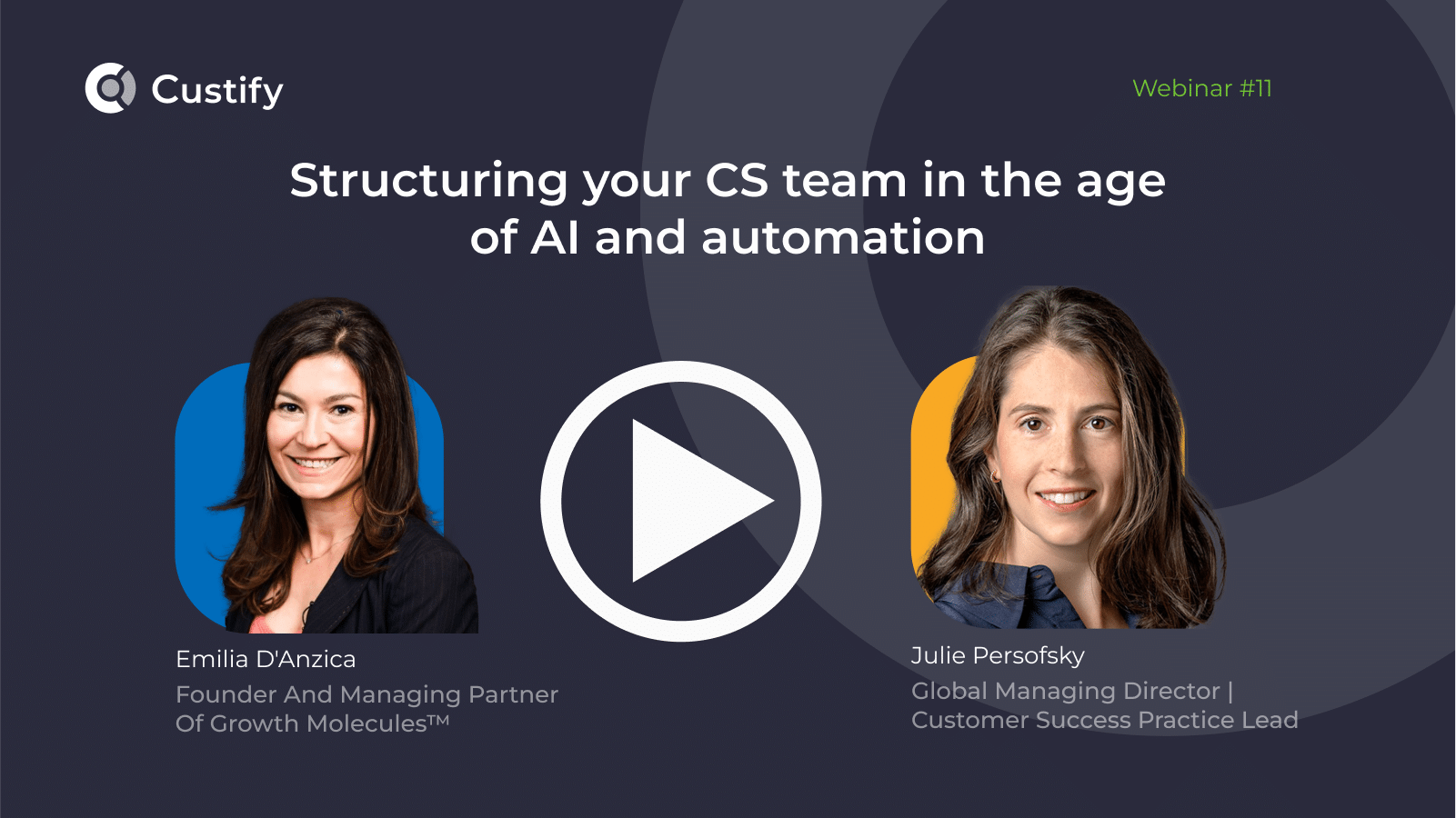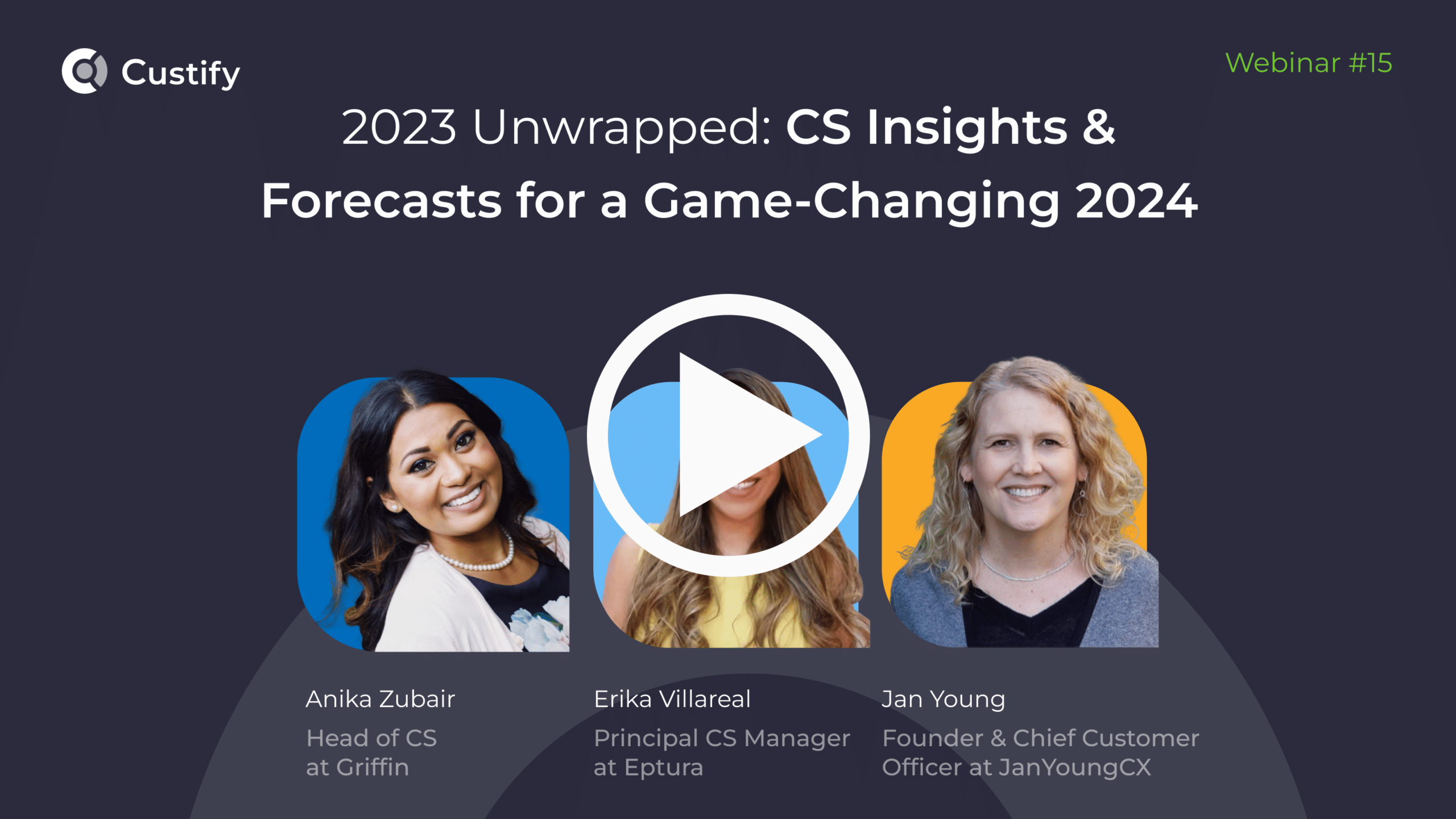As 2023 is coming to an end, we are preparing for a new year in the customer success industry. In our end-of-the-year webinar, Irina Cismas, Head of Marketing at Custify discussed with three influential CS leaders:
- Anika Zubair, Head of CS at Griffin
- Erika Villarreal, Principal CS Manager at Eptura
- Jan Young, Founder & Chief Customer Officer at JanYoungCX
Keep reading to discover:
- How 2023 was in the CS industry
- Challenges in Customer Success in 2023
- How to advocate for a CSP internally
- What are the key metrics in CS
- How to set up the achievable goals and milestones for 2024
- CS budgeting in the next year
Intro
Irina 00:02
Hi, everyone. Good morning. Good afternoon evening. I’m Irina Cismas, I’ll be your host for today’s webinar, and I’m thrilled to be here with you. It’s my pleasure to bring together some brilliant minds as we count down the days to Christmas. Today, we are wrapping up the year with a special session featuring some of the most influential voices in customer success. With no further ado, I want to invite Anika Zubair, Erika Villarreal, and Jan Young.
I hope I pronounced your names correctly. I can’t wait to dive into a candid chat about the rollercoaster that was 2023, and a sneak peek into what 2024 might hold for us in customer success. Ladies, welcome, and thanks so much for joining us, and taking the time to share your insights.
Erika 01:03
Thanks so much for having us Irina, we’re excited to have these conversations very interesting to think about what next year will be coming.
2023 in review
Irina 01:15
Before we do that, I wanna I want to start with a few housekeeping items. Then we deep dive directly into the topic of today. And so I want to say that the event is being recorded. So rest assured, if you cannot online, no worries, we’re gonna send you a copy. And we’re gonna publish the recording. We value your participation. So feel free to post your questions using the Questions tab, it’s at the bottom right of your device, or use the chat function.
While we talk and also try to monitor, we’ll try to incorporate the questions in the discussion or we’ll save them for the Q&A session at the very end. Okay, so to kick things off, I want to begin with the thought experiment. So I want to ask you if you could go back to the start of 2023 with the knowledge you have now, what would be your initial steps in customer success? And I want to start with you, Anika. What would be your approach for the beginning of 2023? With your current wisdom?
Anika 02:33
It’s a great question. I wish I had a magic ball for every year that we can go back to what has happened. But I think in the ever-changing world and customer success that we find ourselves in, it is tough to predict. And so, I’m really excited to jump into this topic.
But if I were to look back at this last year, and start to think about what I would have changed, or what could have changed now that I know what I know, nothing went to plan. 2023 basically ended up being about focusing on sustainable growth and taking Customer Success back into—I don’t want to say its basics, but the fundamentals of focusing on customer outcomes and driving revenue for your business based on those outcomes.
And if I were to look back and reflect, I think the start of 2023 was a lot of what we were experiencing from the tailwinds of COVID or 2020 and 2021, which was “grow at all costs”. We were really ramping up and preparing for the SaaS rollercoaster to continue to succeed and grow. And, you know, much like we didn’t expect to be in lockdown or COVID, we didn’t really expect 2023 to be where we ended up—where we needed to really watch our budgets, how we’re growing, where we’re investing, and what we’re doing in customer success.
So, to answer your question, nothing was planned. And if I were to go back and change the plans, I’d focus on sustainable growth and making sure that everything my CS team is doing is tied back to that revenue piece. Those are my two pieces. I would say if I went back with the magic ball and could change things.
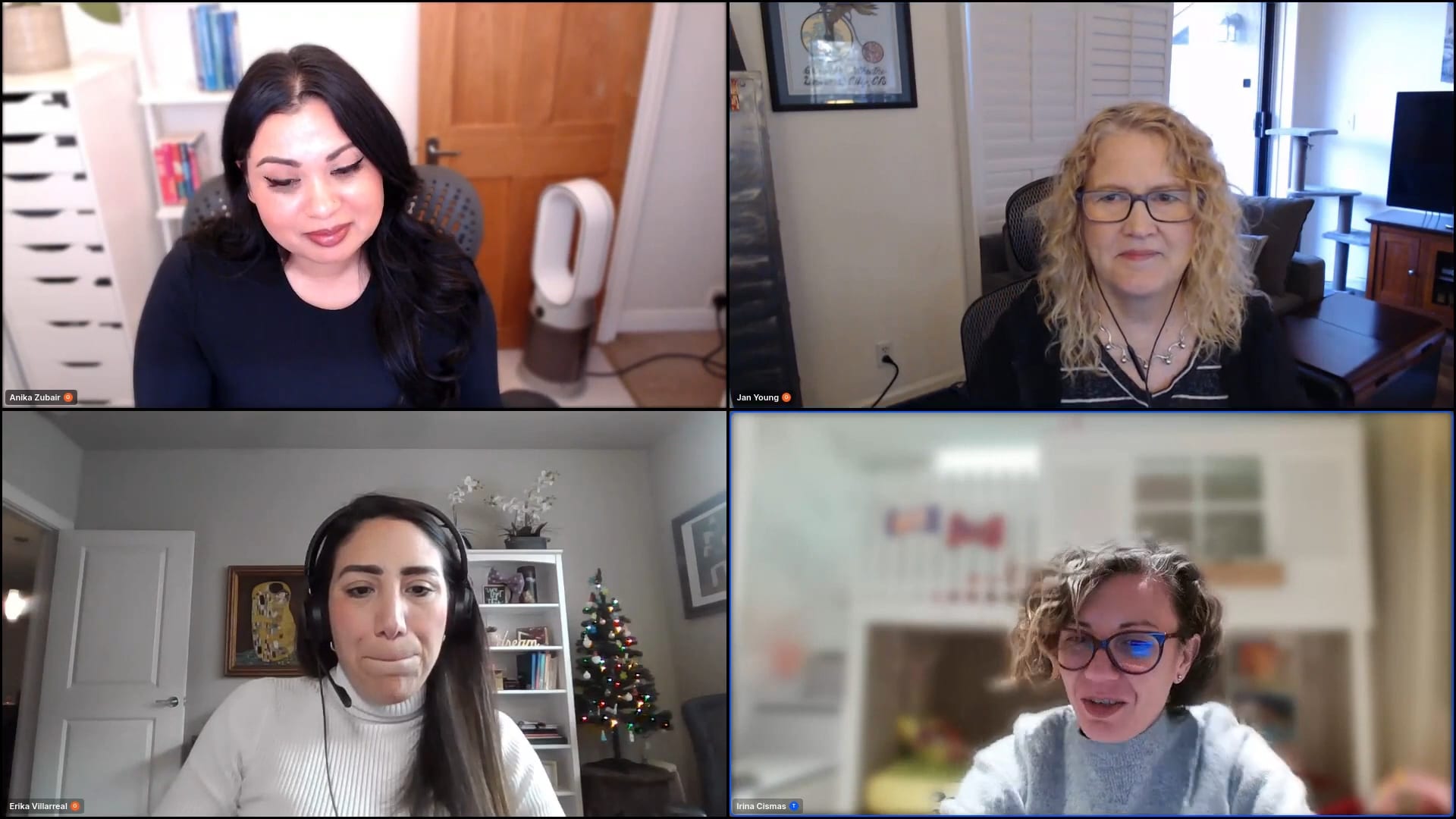
Irina 04:20
Thanks, Anika for those insights. Erika what’s your perspective on this? If you had the do-over of 2023 What would your first action in CS be?
Erika 04:31
Yes, of course. I wish I could do that. I wish I could go back in time to the start of 2023, when everything was perfect, and I was just having a great year. But if I had to reflect on how 2023 went, one thing I would definitely prioritize is customer data.
A little bit of background on my company: Up to this year, we went through a lot of changes—organizational changes, acquisitions, mergers. We brought together nine different products from nine different companies. Bringing all of that data together into one single system was very, very challenging. The fact that CSMs didn’t have any visibility into what was happening with our customers, no way to see the big picture, no way to identify any positive or negative trends was a major issue. The data was wonky; we were trying to fix it and improve how we report on customer data.
So, whenever CSMs were trying to figure out what was happening with our customers, by the time we saw a red flag, it was already too late to act. If I had to restart the year, I would definitely prioritize spending more resources and more time to bring all this data together. This way, CSMs would have this data moving forward into the next year, making sure that we’re using that data strategically to build different success plans, different strategies. This would help us bring customers back into better usage, better engagement. CSMs would have more information on how to better help these customers achieve their business outcomes. That’s what I would do if I had to return to January 2023.
Irina 06:20
Interesting points. And there were a few things that I wanted to dig deeper if we have the time, Jan, over to you, how would you change the 2023 Customer Success strategy?
Jan 06:34
Well, I think that both Anika and Erika have really brought up some fantastic points, both in terms of the way we’ve seen all of SaaS technology move. You know, because money started to cost something, we saw all of it move from growth at any cost to profitability. And so, sustainable and durable growth has really required our attention, right? And when you look at that, then data is, you know, something that’s at the core of that.
But I think too, we could have foreseen this a bit more if we’d been paying attention to the broader markets in 2022. And that’s where, because we’re at the intersection between the customer and the company, we’re not just Customer Success leaders; we’re business leaders. And I think it’s really incumbent upon us to understand what’s happening in the general sort of macroeconomics and marketplace. And if we take a look at how, you know, what’s happening with interest rates, and understand how then that impacts our general business and tech, in particular, startups in particular, are reliant on what’s happening with interest rates, because that impacts investors and what they have as opportunities. Right? When money didn’t cost anything, investors could throw a bunch of money at Tech. And if you had an idea, you could get funding, right? Whereas now, you really have to prove yourself.
Now what you’re looking at is metrics, like revenue per employee, you know, or cost per employee, margin per employee. Right. And that’s the kind of thing that it isn’t just the CFO that should be looking at that. That’s something that CS leaders, because we’re at the intersection between the customer and the company, should be thinking about. Right? And so, I think that we’re going to continue seeing that in 2024.
And then the only other thing I would add in is also what’s happened in this last year is the explosion of generative AI, and how AI is now accessible to everyone. In the same way that you see, like, computers are accessible to everyone just because it’s in your hands now. That’s how generative AI is. That’s how AI is. Right? And so it’s incumbent upon us, especially in 2024, to think about how we’re using AI in small and big ways every day. And it literally should be incorporated into what you do throughout the day, the same way you would have used, you know, like you would have Googled it.
Now you need to, I don’t know if we should call it ChatGPT it, but you know, “chatty”, or whatever people want to call it. But certainly, yeah, we do need a verb, and I’d call it more Gen AI, you know, generally. You know, because there’s going to be so many different ways that we’re going to use it in all of our tools. And that’s really something that I think we want to engage in and embrace not only for productivity but for the trends that we’ll get from the data that we’ll be cleaning, the Erika talks about, and to the end goal of being, you know, creating sustainable and durable growth for our customers and for our companies.
CS Challenges in 2023
Irina 09:58
Thanks for those insights. And before we move on, I’d like to bring our audience into the conversation. And I want to publish a big poll, because I’m curious, what’s their take on this year? And what were their challenges? And I want to debate on those challenges. So give me one sec to be able to publish the poll.
Erika 10:25
Go go very curious. I’m very curious to see what comes up.
Irina 10:35
Do you see the poll? Now?
Jan 10:38
I don’t see the poll. I always love polls.
Irina 10:52
People started to vote, we’re gonna give it a few more minutes. And I encourage everyone to vote. Because you’re because your votes will give a different flavor to our conversation.
Jan 11:51
Managing and reducing customer churn, of course.
Irina 11:54
They only had one option so they could only pick one thing from the whole thing. We have managing and reducing customer churn. We have scalings. Scale operations. The second was scaling and aligning the strategies with the overall business goals. For the ones who published “others” please post in the chat. Give it a few more minutes.
But somehow, this actually sets the perfect stage for the next topic, you Anika mentioned it at the very beginning, not every strategy unfolds as planned. However this gives us, I would say the chance to learn some valuable lessons. Erika our audience pinpointed as biggest challenge, reducing churn scaling the CS operations, and I would also mention aligning the CS strategies. Why do you think we encountered those types of challenges? And what should we do to prepare? If those changes remain next year? How can we how can we prepare? First of all, let’s understand why and what can we do better.
Erika 13:47
Sure. And I’m going to tie my answer very similarly to what I shared on data at the beginning of this webinar. I feel like one of the things that we should do better for sure to manage expectations and reduce churn for 2024, and what we’ve learned from 2023, is making sure that we have proactive customer engagement. With data analytics, we can learn more about what customers are doing and start being more proactive instead of reactive. You know, for me, this year was a very reactive year because I didn’t have this data.
A way that we could solve these challenges is to make sure that we have good health scores implemented, that we have ways to inform our CSMs of red flags that are happening with our customers, and that we can implement an engagement model. We should have automated messages, personalized messages that can be sent to these customers to prevent them from stopping using our tool or from seeing less value in the solution that we’re bringing to them. So, for me, one way that we could solve for this is definitely by working on that engagement model. It can help us better stay communicated with our customers, and make sure that we are delivering value across their engagement journey with us. So that’s what I would do to reduce churn.
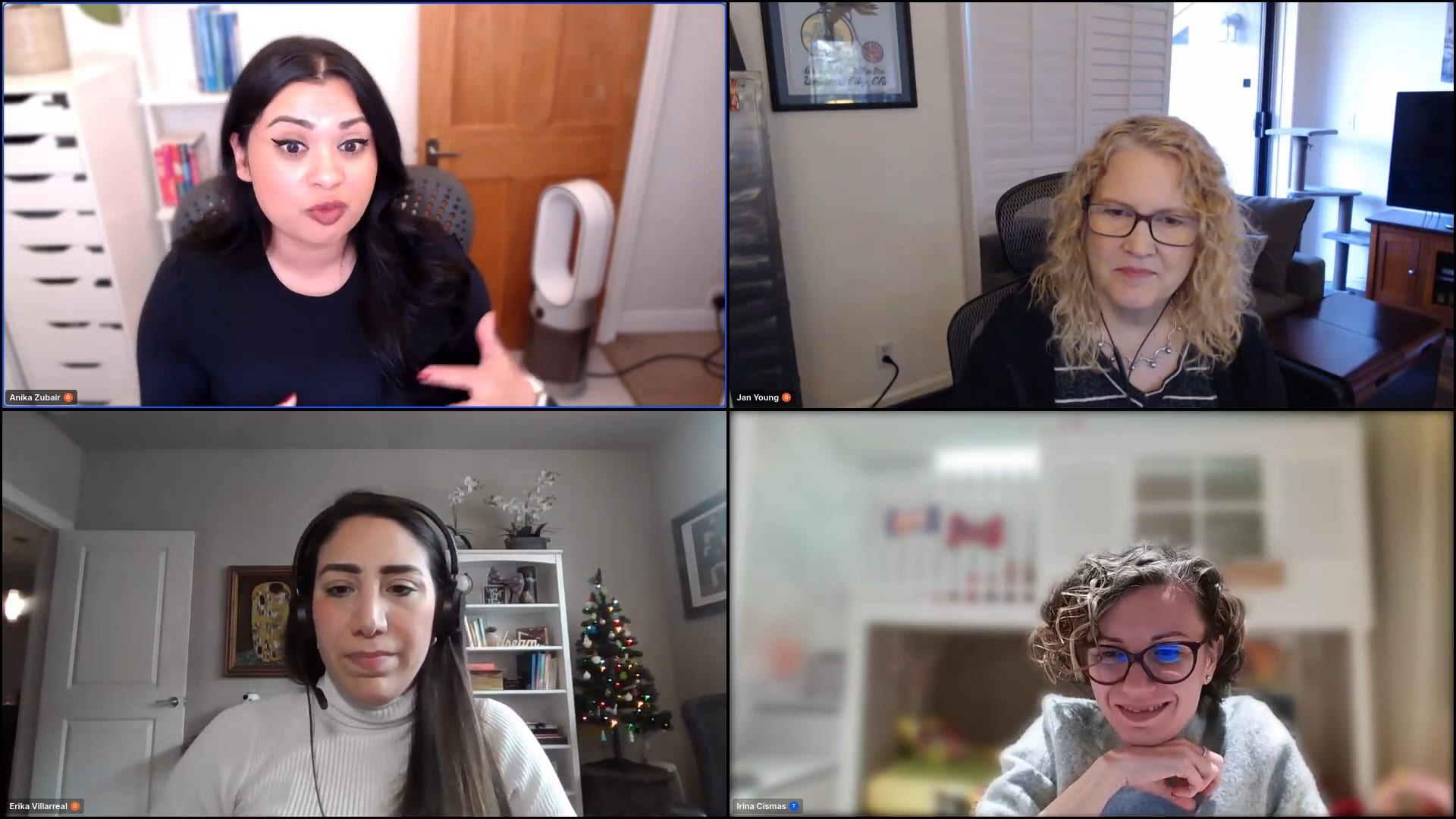
Irina 15:17
Thank you for the insights. Jen, why do you think the CS strategy fell short in 2023? And what do you believe is the main reason behind its ineffectiveness?
Jan 15:30
Well, I mean, if you think about it, we’re constantly evolving, you know, in terms of our SaaS Tech business. If you think back 15-20 years ago, even product was talking about customer delight, right? And what was CES? It was the happiness department. And there’s still a little bit of hangover from that, right? Where we’re trying to serve our customers, make them happy. And if they have a support issue, yeah, sure, we’ll dig in, we’ll help you with that. But actually, that’s the wrong thing to do. We have a support team. And by taking on a support issue, instead of letting your support team handle it, you’re preventing them from having the ability to track it, or to create education materials for it, or to be preemptive around it, or any of those things. So you’re not only taking away from your support team, you’re also taking away from your customer. Because instead of helping them with the strategic ways they can use the product and meet their business objectives, you’re helping them with a support issue, which can be addressed in so many other ways that are much more efficient and effective. So you’re not focusing your time on what can really help your customer. And that’s all in the name of happiness, right?
And, frankly, a lot of happy customers churn for a lot of different reasons, because happiness isn’t the core reason why they stay. They come for a business reason. So I think, you know, what you need to focus on is what’s going to have an impact, right? What’s going to have an impact for your customers, what’s going to have an impact for your own company and your own business, and think about what that intersection is and where they marry. And that’s where you want to focus your time. There are so many things we can be doing in a day; you don’t have the time to not be effective or efficient with your time.
Advocating for a CSP internally
Irina 17:32
On the chat, Steve mentioned that one of his CS challenges this year was maintaining the perceived value of CS during tough times. And what I want to ask you is how to advocate internally for your CSPs. And how do you make sure that your peers see the seeds of value? So what’s the narrative that you bring in into the companies that you are working for? Anika, I want to start with you this time. How do you pitch for your team? How do you prove the value of your CSPs?
Anika 18:15
My whole career has been about pitching the value of customer success internally. Luckily, my current organization is very much aligned on this. But that’s just the newest organization I’ve been at.
In my previous roles, I feel like you’re constantly trying to prove the value of what we do. And I think a lot of that has to do with the fact that we measure ourselves on a lagging indicator rather than a leading indicator. And due to that, a lot of the value of customer success isn’t tied back to the business, per se. And if you think about how a business works, it’s ultimately a profit and loss statement. How much money do you make? How much loss does the business incur? More times than not, customer success is tied to the loss leader, rather than the profit center. This is due to the way that we are perceived. From my personal experience, we use NRR as our leading metric, which is actually a lagging metric because it’s something that you look back on to try to forecast the future. But as we know, stellar NRR in 2021 and 2022 led to not-so-stellar NRR in 2023. So if that’s not evidence enough that we’re measuring based on a lagging indicator, then I don’t know what else is.
But to bring back to Steve’s point about perceived value and CS, and how you align that internally, it’s about making sure as a leader, but even as a CSM, that your value is towards a leading metric that’s bringing profit into the business. That’s my first standpoint on that. I very much believe in aligning the wider team to the entire customer journey. So that means that from your BDRs to your CFO, to your support engineers, to your product managers, everyone should know exactly what’s happening with the customer from the day they hit your website to the day they exit your company. And I think that a lot, like if I were to ask some engineers in some companies, they wouldn’t know how the onboarding of a customer would work. And the same thing goes for, I don’t know, an SDR. They’re so focused on building this pipeline for sales to close, but they have no idea what happens once that sale is closed.
So in order to really show the value of customer success, you should have a lagging metric as your team metric. But you should also really align what the heck you’re doing across all your teams. And you can say that till your face turns blue, but it is an active thing that you have to continue making sure you’re doing across teams as well.
Irina 20:56
Erika do you want to but do you want to build on what Anika said? What’s your view on this? Next I have a question for you Anika. But I want to pick Erika’s brain on this as well.
Erika 21:10
Sure. I completely agree with Anika’s point on this. I think Customer Success should be ingrained in every department of the organization. And I think business is measured on revenue, right? Leaders care about revenue, which is why we’re always looking at NRR and DRR. And how many CSQLs we’re closing, and how we’re helping sales to sell more referrals, and all of these things that customer success is also doing, and sometimes are left unnoticed. Right?
So I feel like for CS to be able to continue getting the budget that they need and making sure that they continue to grow Customer Success departments in the future, we need to continue to communicate all of these metrics on how we contribute to that revenue line, and how we’re helping the company grow, and how we’re helping our customers better achieve their business outcomes. So it’s a little bit of everything. And, as Anika said, making sure that we’re looking into the whole customer journey, and not just where Customer Success takes place.
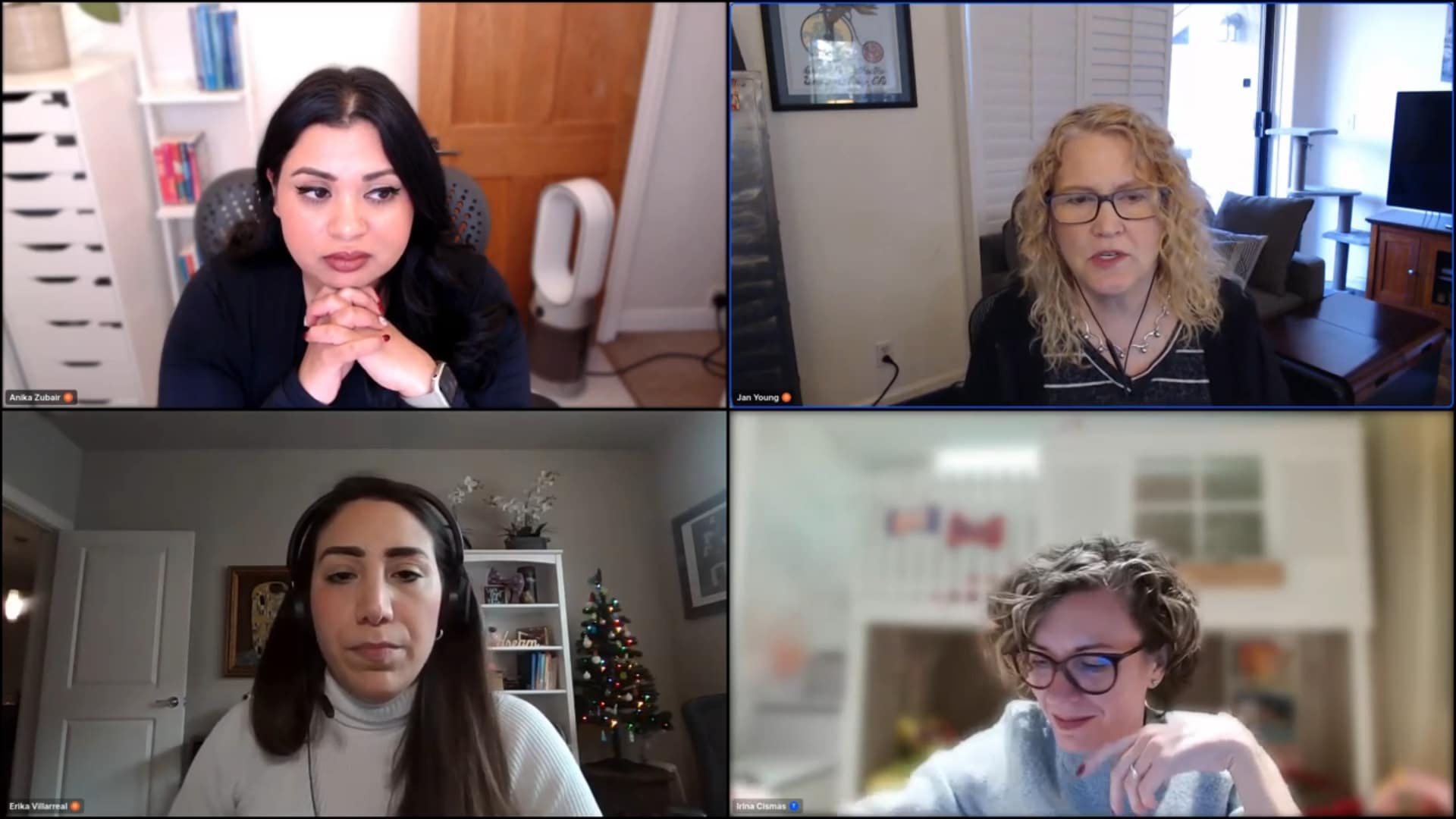
Jan 22:23
Another thing that we can do is actually take a page from the book of the pre-sales motion. If you look at the way that rev ops dissects every single moment in time in the pre-sales motion, they know what’s happening with the conversion points, and what their conversion rates are at every moment. As CS leaders, we can actually take a look at the post-sales motion in a similar way. If we know how the sales to CS handoff is taking place, who’s involved and engaged, and just kind of look at any sort of things that we can measure with that, and keep track of that for each of our accounts, then take a look at how long onboarding is taking, when they’re getting their time to first value, when they are launching, what’s taking place with adoption, how many people are adopting and how quickly, you know, are they optimizing? What things should they be doing to optimize, when and how have they optimized? If you’re tracking all of the things that we’re generally trying to do in these qualitative ways, but also track it in a quantitative way, we can start to understand how we’re doing, sort of tracking those conversion points for our customers, and then how that leads to renewals and expansions in a way that then that’s basically money.
And so when you take a look at all of those activities, because so often, the pre-sales folks or people who were overworking in product, and engineering, they don’t understand what’s happening in our area any more than we understand what’s happening in their area. But they do sort of assume like, “Oh, they signed on the dotted line, threw it over the fence, and now it’s just going to happen,” except for it doesn’t just happen. And if we can actually track and show what those conversion points are, how it leads to revenue, and how we can make improvements in those areas, to then lead to better revenue, then we can also show what we’re actually doing and what we’re achieving that leads to the revenue numbers. Right. And it’s all of that that we then can start to relay back as we communicate, “Oh, we improved this conversion metric here in onboarding. We expect that to have some impact later on when we’re doing renewals or expansions.” That’s sort of right. And so it’s really important to not just communicate the qualitative ways, and have the stories because people relate to the stories, but also back it up with the quantitative.
Key metrics in CS
Irina 25:14
Thanks for the thanks for those insights and completion, Jan, I promised a question as it was in the context, she asked which reading metric should see us focus, it was tailored to you Anika. And she also was presented with a great round, it’s in customer education. And she said, we can focus on what classes where content is created and what customers consume. What leading metric can you show?
Anika 25:48
I’m happy to address the first on the leading metric on the CS focus piece. For me, personally, like I said, NRR is a for it’s a great metric, because it’s showing you how much obviously you’ve grown over the last year. But it’s really hard to predict future revenue based on NRR. Because, as we know it, what’s changed over time. But for me, I look at how Jan, just adding on to what Jan said with the pre sales or sales team use as motions or metrics. If you think about it, a sales team thinks about closed one break, or they think about CSQL to MQL rate. And they think about all of these metrics that tie directly back to future revenue for castable revenue. So if you take that same logic, which I think we should all do, by the way, I think CS gets really drawn away from sales. And I don’t know why. But I’m hoping that that narrative changes. But if you take the same concept of how sales forecasts in that way for closed one rate, or like conversion rate, take the same things and use those as forecasting to future. So I would say time to value, I would say, when we’re talking about renewal intent, or renewal rates, as well, I would also talk about, you know, CSQL to close one rates, those are all for castable future rates that you can start to predict to that profit line of a business. So what I would say is leading indicators and customer success is any metrics that tied to revenue towards profit towards the business. And I think it was Jan, that said that we’re all business leaders, which is I couldn’t agree any more to that and how we become business leaders is how we tie those metrics to that profit piece. So and I don’t know if I can answer to the customer education part. I consumption is a good point, though, Pam.
Goals and Milestones for 2024
Irina 27:39
I think the customer education part was just to provide a bit of context, the way I was sending it was the industry she’s activating on, feel free to develop on chat, and we’ll pick it up later on at the end of the conversation. Now I want to flip the coin as we talked about 2023. I want to discuss about 2024. As we approach it, from my perspective, the emphasis isn’t just on breakthrough outs but also on those small milestones and everyday steps that lead to the overall growth. Jan, can you share some realistic goals or milestones that CSM should aim for the next year to ensure that they are making steady progress?
Jan 29:03
I’m sure that both Erika and Anika would also agree, because I really have a lot of respect for them both as CS leaders and CSMs. But what I would say is this: think about your company’s goals and your customers’ goals. How and where do they intersect, and where do you have an impact, right? When thinking about those larger goals, then you want to break them down. What does that mean? If this is what’s going to happen over the year, what does that mean for the quarter? What does that mean for the month? What does that mean for this week? And how can I then break down my day to devote time towards these activities each day? Because we only get there step by step.
So, if you’re analyzing your overall conversion rates that are leading towards adoption, optimization, renewals, and expansion, and you can see that you have some sort of leak in your bucket in some place, like which one is the biggest one that you need to have an impact on? Try and work on that one first. It’s also about the writer of the 1%, you know, kind of atomic habits. I know we’ve read that; we’ve talked about it. So it always gets down to those atomic habits, right? You don’t get to the big goals without working on them in small ways every day. But oftentimes, we forget to work on them in small ways.
And so, think about how you can break down your big lofty goals. But also be sure to identify what they are, connect what you’re doing in CS to your business, connect what you’re doing in your CS role to your customer’s business. If it doesn’t have that connection, it probably isn’t that important. Think about how to make an impact by working on the critical things that are going to move the needle.
Irina 31:14
Erika, what small but at the same time significant steps would you suggest CSMs focus on for substantial progress next year?
Erika 31:23
First thing, I am going to use that atomic habits reference from John because first of all, I love atomic habits, and I think that succeeding as a CSM in 2024 has everything to do with habits. So, one of the first milestones I would say CSMs need to really, really deep dive into next year is making sure that they have a lot of knowledge about their customers. This means having clearly identified their business goals, understanding the challenges they’re facing, drilling down, and building those success plans, because success plans are what help you help customers achieve their goals, right. So, if we don’t have clarity on what those goals are, or we don’t have clarity on the challenges they are facing, we will never be helping them get to point B. That’s the first thing that I would do.
Another thing that I would focus my energy on as a CSM is communicating with leadership about all of those roadblocks that you see, or places where during the customer journey, you’re seeing friction. Whether it’s friction on the support side or friction on the onboarding side, or if you have a process improvement that you can bring to your leadership team to fix those gaps, I would focus energy on that as well.
And finally, back again to data, back again to research, back again to monitoring health and making sure that you’re always constantly reviewing the data that you have from your customers so you can make better and informed decisions to help them achieve their business outcomes. So those are the three mini achievements, I would say, that I would focus on to make sure that I’m succeeding in 2024.
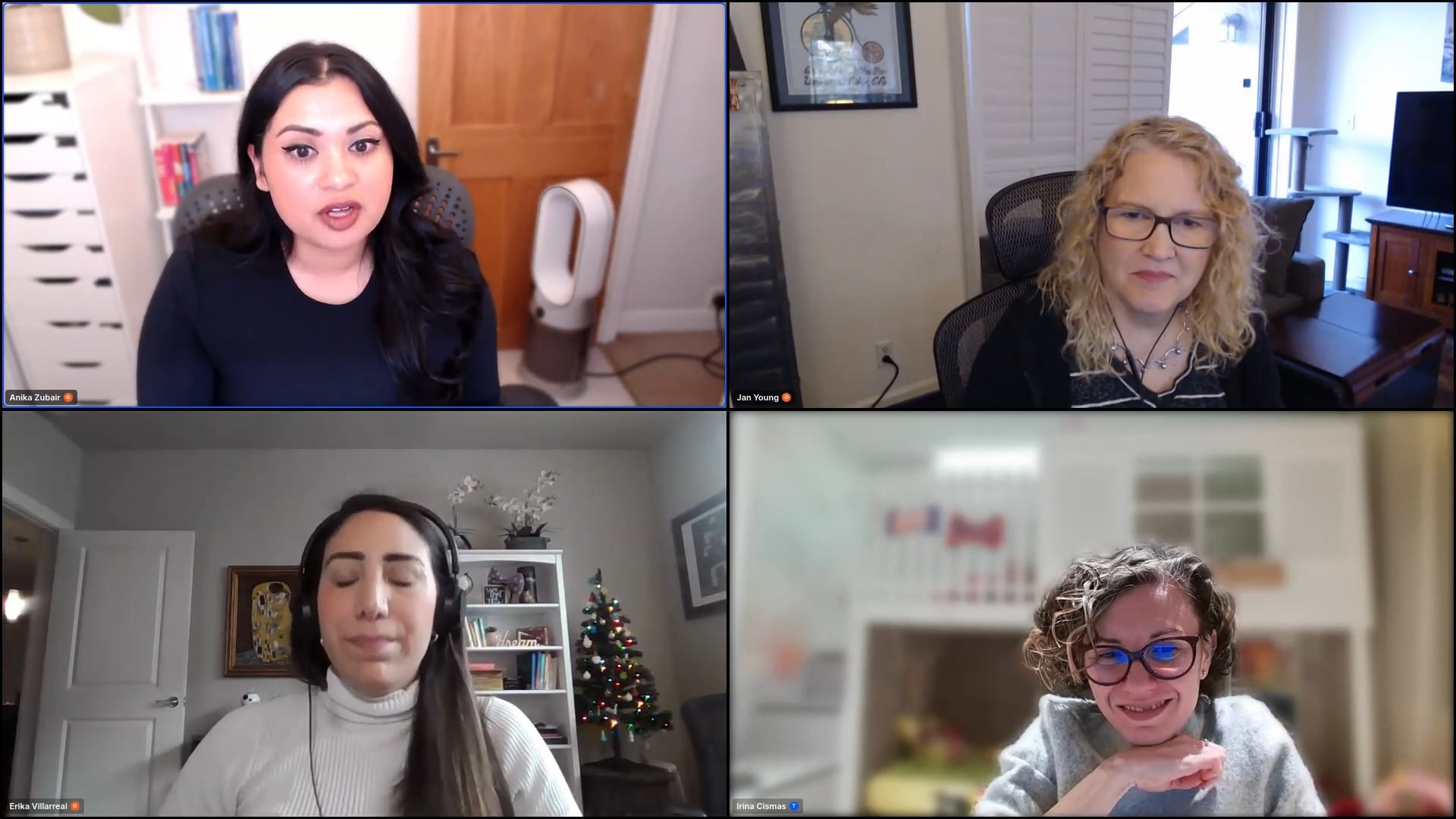
Irina 33:11
Anika, what’s your perspective on this?
Anika 33:13
I mean, Jan really covered the whole 1% thing. I’m a big believer in that, by the way, like in every aspect of my life, I try to take one more step from yesterday to today, for example. So I’m a very big believer in habit stacking, but also in making a 1% change. I also really believe in reflection. I do monthly reflections on what I’ve done really well in the last month and what I plan on changing in the future months. So, if I were to look at 2023 and think about any of the learnings or takeaways that I had, I would then try to apply what I’m trying to learn from 2023 into 2024.
And I would also say that in order to be proactive, you need to be able to find the balance between the firefighting and what you proactively want to do. And the only way to be able to do that is to balance both each month. So know that you’re going to be reactive. I don’t think we will ever move away from that world, as much as we want to be and as much as we say we have every strategy and every playbook to be proactive. Like, stuff is going to come up, sorry. You’re going to encounter issues, and we’re not going to avoid that. But what you do have to do is be able to balance that proactive and whether that’s one strategy a month or one thing you’re doing differently each day, I would say just take what you’ve learned. Did you firefight too much on churn? Or did you not have a very strong renewals playbook from last year? Or was your onboarding really weak and you ended up going over time to value? Take data metrics, points, whatever you didn’t hit in 2023, and tweak it slightly and do it again, one per day, one per month, whatever is attainable. And know that there is balance; we are going to be firefighters at some point, but we also need to be proactive on the other side too.
CS Budget in 2024
Irina 35:03
I want to ask you about budgeting and customer success for 2024. And there’s no way I can sugarcoat it or introduce it rather than direct. We will live in, I would say, a shady economic context where every penny counts, and every decision needs to be argumented. So how we defend and allocate our sales budget becomes more important than ever. Erika I like to start the discussion with you with budgets being closely watched, what strategies would you recommend for not only defending the CS budget but also ensuring it’s allocated in a way that maximizes the impact and the value?
Erika 35:49
I feel like it all tracks back to revenue and how we measure it. So for CS leaders to be able to secure their project 2024, they need to clearly quantify the ROI or the return on investment that we’re bringing to the organization. And I think one of the easiest way to do that is to tie them back to the metrics that you’re measuring, whether it’s NRR, growth, revenue, retention, CSQL, referrals, anything that your team is responsible for that contributes to that revenue line, you need to make it clear you need you need to communicate it constantly. It’s not just like every quarter like sharing customer success stories that mark things that have gone well, and where your team has had a big impact. That brings back to revenue. So it’s all about, it’s all about how you communicate those metrics to secure the budget.
Irina 36:43
Jan, what’s your take on this on the budgeting? What’s your recommendation?
Jan 36:50
Well, this is where getting close to your CFO is important, as well as understanding what investors are looking for. So, things like the Rule of 40 – how you contribute to both profitability and growth – are important, especially if your company has an overall revenue of 20 million or above. But then you also want to look at what your margin is. What are you contributing in terms of revenue as well as costs? On a per-employee basis, how are you contributing to that revenue? What is the cost of contributing to that revenue? If you can understand those metrics and speak to them, then of course, you also want to be able to show what you’re using humans to do, what you’re spending on your tools.
Oftentimes, especially in early-stage companies or back when it was growth at any cost, humans were thrown at problems when there wasn’t the budget for engineers to build things out or while moving on to the MVP, leaving a lot of customer friction in the wake. So, what you want to look at is where you could reduce the number of humans where it could otherwise be products that are built out more efficiently, or tools that can be used. By this, I don’t mean so much reducing the humans, although you may be asked to do that. And frankly, CS leaders have been asked to do that several times, even with their own teams in one year. That hasn’t just been one round of layoffs in many companies; there have been several. But regardless, you also need to understand what the trade-offs are. If you are going to remove another human from this team, you can’t do as much as you did before. Or if you’re going to do that, we need to then make sure that we have a CSR ops person who’s going to manage this additional tool, and we can trade it off in that way.
But really, it’s about understanding the overall metrics that the business is looking at, how you contribute to the margins, and then also showing what the actual impact is to the business. Again, looking at those conversion points throughout the process and what the impact on those might be. So that might even influence a decision. You might decide to keep an additional onboarding person and not have as many CSMs, and then do more tech touch. If you can do it in a smart way or in a way that doesn’t impact your business too greatly, you can arrange things a little differently. You have to think about how you’re going to structure the team to still achieve the most important goals. Think about how it’s contributing to the margins of both revenue and cost in that way, and what sort of trade-offs you can make. Frankly, it’s a time to be creative as a leader. And it’s hard because you also know that you’re impacting your team, and these are people that you care about. But sometimes they can switch over into other roles, and you can help them do that. Other times, it’s just time for them to move on, unfortunately, because your business, in order to stay in business, can’t afford as many humans as it once had. So those are some of the things that we think about.
Irina 40:48
For me, working in marketing, I see this as a paradox. So everybody knows about customer success everybody talks about it, everybody speaks about its value, but when it comes to cutting budgets, they are the first department from where we are cutting or from where we are taking the budget. Anika, what’s your take on this? How do you secure a budget for next year? How does your budget look like for next year?
Anika 41:24
Well, the budget’s already done for next year. So, but I can definitely speak to the struggle of budgeting in general and what I think CSA leaders and CSMs are facing. And I can echo everything Erika and Jan have already said. I’m a big believer in a four-step process, and I’ve talked about this in a number of talks I’ve given, which is people, process, repeatability, and tool. It’s very basic, but it’s how you build and scale teams. We already have the people piece; we’ve figured that one out. We definitely have hired – overhired, underhired, whatever – we’ve hired the people.
I definitely think that when you think of budgeting and how to be creative within your budgeting, you have to think about the process you’re building and if that process is repeatable. The number one thing I’ve heard this year is “do more with less,” and “figure out more with less,” whether that’s less people, less tools, less insights, whatever it is. Being creative with that is up to you on how you do that. But I also believe in being creative with that process and repeatability piece because, for example, you can build a process on a whiteboard, or you can build a process on a piece of paper, you can build a process on a spreadsheet; it does not need something fancy, first of all. So if you don’t have the budget, you have other tools literally in front of you to do that.
And the second thing is before you go out to market to buy a tool, the reason tools are the last step in my people, process, repeatability model, is that there are definitely tools that are just in front of you that you can use that the company is already paying for, that you should be using before you go and reach for budget for other things. Because to be honest, we’re not going to get the easiest yes from our CFOs right now. And it’s easier to build out a process and repeatability and then go ask for the budget once you’ve built that out because you’ve proven a model.
So as a tangible thing, I would say go build some sort of data visualization in Excel and build it and build a graph. You don’t need a BI tool or data analytics right away. But Excel is magical. And if you don’t know how to use it, there’s YouTube. There are a lot of things that we can figure out and be creative with. I just think that with budgeting, we have to be super creative and there’s so much right in front of us. And I think when cash was cheap, we were like, “Okay, hire the people, we’ll build a process, we’ll buy a tool,” but we don’t have that luxury anymore. So when it comes to budgeting, I would just say be very mindful of where you’re spending your money, but also be very resourceful and very creative with what you have in front of you. So that’s my two cents on budgeting.
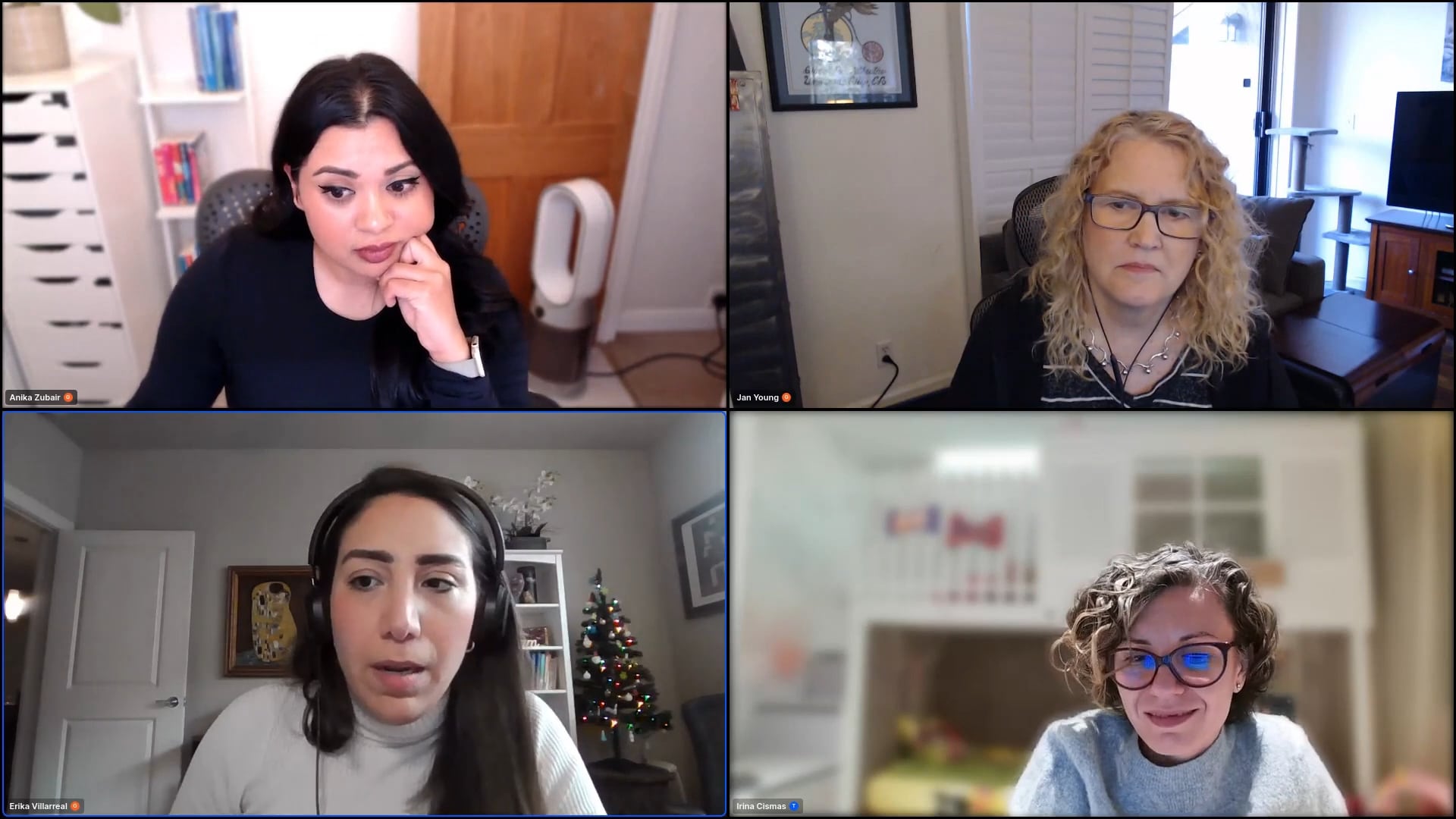
Erika 44:14
Resourcefulness is a great skill for Customer Success leaders for sure.
Anika 44:19
I feel like we should all go in and endorse each other on LinkedIn, is that still a thing? This has to be a typical trait in customer success.
Jan 44:28
Yeah, yep.
Q&A
Irina 44:30
With your permission, I’m going to start addressing some of the questions and Amber stated: With the current tough economic climate, how do the customer success managers stand out for promotions and or new job opportunities since these are harder to come by? Who wants to have a first round of answers on this?
Erika 45:05
Well, this is something that I’ve been trying to do too. And the way that I’ve seen works best is bringing your own metrics and advocating for what you’ve done over a year.
So, if you can look back at what you did in 2023, how much revenue you brought in, how many upsells you achieved, if you received any reviews from customers, any customer stories that you’ve shared, anything that you’ve done that speaks to revenue, put it in a document. Create a STAR (Situation, Task, Action, Result) document where you can say, “This is what I achieved this year. This is why I deserve a promotion. And this is what I’m doing to get that next promotion.”
So, if your people are numeric – and I am numeric, I feel leaders are numeric too – if you are able to bring all of those numbers together, you can probably convince them to give you that promotion. So, at least that’s the way I see it. That’s what I’ve been doing for myself. And it’s worked in the past, maybe not for next year, but let’s see how that goes.
Anika 46:07
I couldn’t agree more, by the way. And the only thing I would add to what Erika just said is, I think we do this all the time as CSMs. And you should do it when you’re advocating for your own promotion is make the math make sense. So just like Erika brought her numbers and showed her ROI to the business, she was like, “Listen, this is how much I get paid. This is what I do that hits these numbers. I deserve a promotion because actually, I’ve made the business X number of dollars.” And that’s a great narrative. But it’s also about making the math make sense for your leader.
So, I would say if you are advocating for a promotion or a new role in a tough economic climate where budgets are tighter than ever, make sure the math makes sense. Because if you can’t do that, then is it really justified? And also, if you can’t justify it, definitely no one else is going to justify it for you.
Jan 46:58
Yeah. And Erika actually did a YouTube video and has a Google sheet where you can actually track all of all of the numbers around your accounts. And we feature that on CS Office hours, in November we’re going to get a YouTube channel up for recording.
Irina 47:19
Then share it with the audience and the link, please. If you can’t find it, I’m going to make sure that I add it on the Repost. And on this recording, we’ll also want to send that template because I think it’s useful.
Jan 47:35
And that’s another thing too, even for CS leaders: you want to think about how you can step up as a business leader. Perhaps you’re not considered part of the executive leadership team, but it’s really critical for your customers and your company that you are part of that team. It’s about the way you present your understanding of the metrics and the ways that you’re contributing to the revenue versus the cost and what those margins are. You want to be able to speak to that as well as a way of bringing in that voice of the customer. This helps you project what you see as the opportunities for 2024 and each quarter. It also helps in identifying some of the challenges and where the at-risk accounts are, and where you can address it as a team, as a company together.
Because sometimes it’s something around the product that needs to be addressed. Sometimes it’s a tweak in how you go to market with marketing and sales that can bring in better Ideal Customer Profiles (ICPs) that are going to create more revenue for your business. You want to think about all the ways that you can share the information that you’re getting from your customers, share it back with your company, both to improve what you’re doing with revenue, and also to fix the leaky buckets. And if they see you as the primary resource for that information, then they need you in every executive conversation. And that’s how they should be seeing Customer Success (CS). And if they don’t see it that way, it is incumbent upon you to figure out how to speak in those terms for your specific customer base and product for your business. Because that’s how you make a difference, not just for your own career, not just for your CS team, but for your customers and your company.
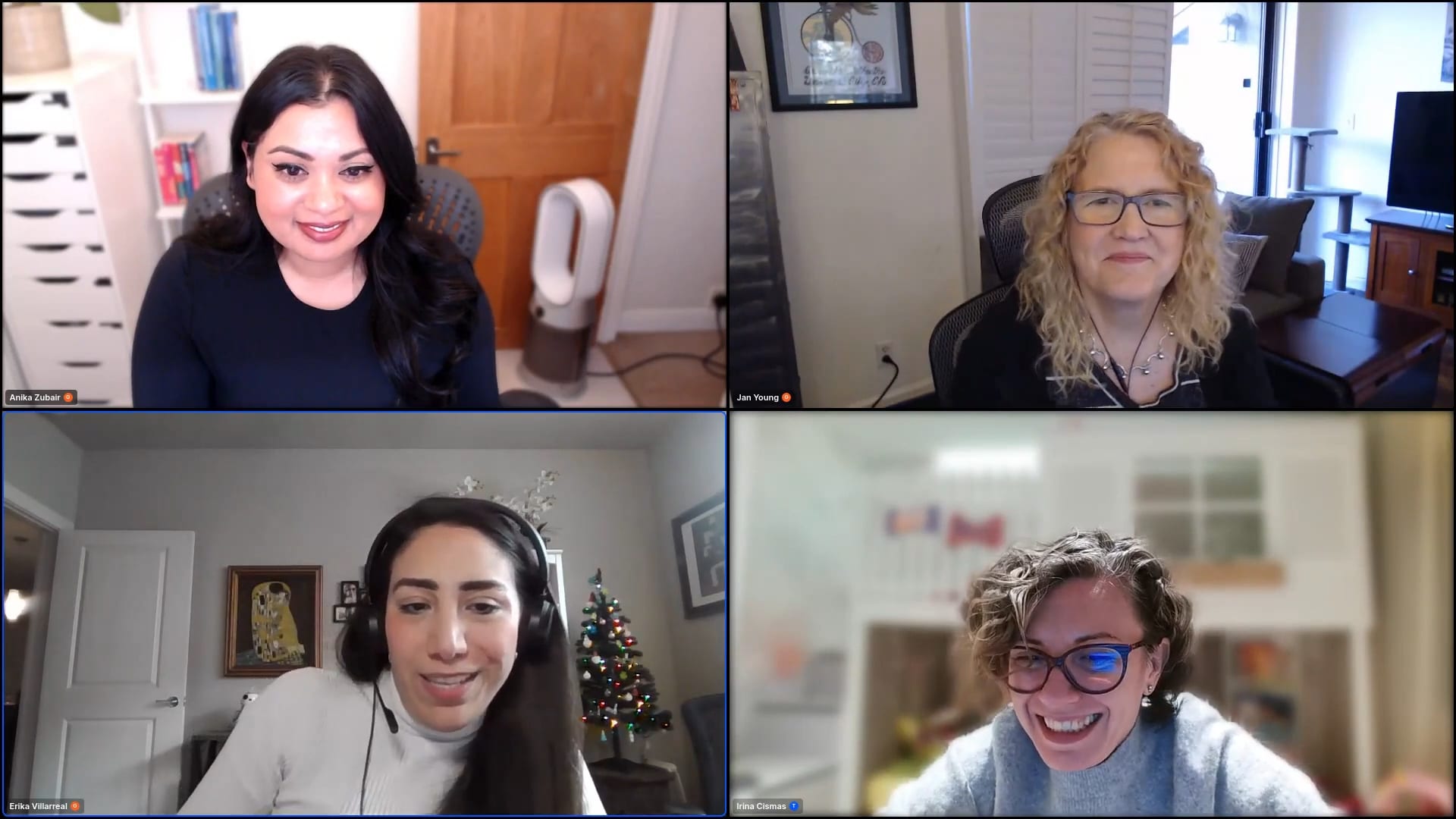
Irina 49:42
Because we only have nine minutes. What can I say Jan? You were right when you said that I prepared so many topics and with all three of you, we don’t have time. So I’m gonna promise the audience or a redo on this executive formula. If all three of you accept and we do take two, I would say that didn’t discuss it. But now I want to take the questions from the audience. And the one for Liz: What distinguished the customer success approach for end users compared to businesses purchasing the software and employees being the end users?
Erika 50:30
I am not sure if I understand the question.
Anika 50:35
You’re asking about the different approaches you should use for your champion versus an executive buyer, right? That’s what I’m understanding from your question. Please feel free to correct me in the chat if I’m wrong. But I’ll have my first stab at it. If that is the question, in terms of distinguishing strategies around an executive buyer versus your everyday champion, I would say that with an executive buyer, usually that person has bought a product and they want to know the outcome or the results of that product. So, unless you’re talking about ROI, or the math, or the metrics, that person is probably looking for that piece.
On the other hand, the champion or everyday end user that you mentioned is going to look for best practices. They’re going to use it for efficiencies, for how to get the most out of the software with new product releases. So, I would say those are the two personas. That’s my take on it – how you should differentiate your strategies: something towards metrics for the executive buyer versus something towards actual usage of the product for the everyday champion.
Irina 51:42
And I want to I want to take another deep dive a bit, how do you because they have different outcomes, the executive buyer versus the day-to-day users. How do you prioritize? Or how do you make sure that both of them are happy if they have, I would say, not necessarily different goals, but the milestones, the expectations are different? Do you try to satisfy the executive buyer to make sure your tool or the expense remains? Or do you focus on the ones who are using it on a day-to-day basis?
Jan 52:25
Yeah, just to answer that question, but also to build on what Anika was just saying, I think what you can do, especially if there’s a difference between being a high-touch CSM versus a low-touch CSM, is to understand that there are basically personas within a company. You want to understand and architect what those personas generally are. If you’re a high-touch CSM, then you’re going to go a little deeper and be very specific for each company that you’re managing in your book of business. Understand who the different players are – some may be influencers, others decision-makers, and still others might be the actual end users.
Understanding generally what they need, and you may be able to deliver on that in one-to-many ways, say, for the end users, or may be able to provide information back to the product team in terms of challenges they’re having with the product, or new opportunities for what they need from your product that you might even be able to upsell to them. This helps in achieving their business goals, making them more sticky to your product, and less likely to churn.
When you’re asking for something like that, when you’re strategically looking across your book of business as a CSM, or across your overall business as a CS leader, you want to understand what’s going to have the most impact across all of your accounts or in terms of your ARR. Also, you want to take a look in terms of what you’re prioritizing. Again, that goes back to what’s going to have the biggest impact in terms of revenue, not just short term, but also long term. Are there going to be some things that you need to work towards building day by day, and other things that are perhaps more reactive, or just something you need to be proactive about this week?
But you want to structure it out and look at what’s happening across your book of business or across your customer base in terms of what’s important in that way. So, I’d love to say, “Oh, make this one your top priority,” but it also depends on what’s generally more at risk or on fire. If you don’t have many relationships with your executive buyers across the board, and that’s leading to the most churn, that is not uncontrollable churn. I’ve worked with a company that tried to say having no relationship with executive buyers was uncontrollable churn – that’s not it, you can control that. That is then your biggest fire that you need to address. And how do you address that methodically? And how do you understand that persona? But it also depends upon what your biggest pain point is.
Irina 55:25
We have one more question and I don’t want to end the webinar without answering all of them. So that’s from Platon, and being from the Caribbean, the position of CS is rather new in comparison to the world going in the speeder way CS is evolving worldwide, how do I balance and manage to keep connected to the developing speed of the Caribbean regarding using data, B2C not sure of the markets here. I’m also reading it as we speak, to make sure that I clarify it.
Anika 56:10
I mean, I’ll take a stab. I’m not sure if I’m going to get this right, but I would say from being from a part of the world where customer success is under-understood, I think that’s the right term. I’m American, as you can probably tell from my accent, but I’ve spent the last 13 years in Europe, and Europe tends to follow the trend of what the US does when it comes to customer success. I would say finding the right thing that works in your region is also extremely important. So, I don’t know the Caribbean market that well, but you do. And taking and learning from other markets, I would say, would be a great way to make sure you’re up to speed with what’s important to ramp up in the Caribbean.
Using data or market trends might not be the norm there. But what I would say is, it’s not new—you have other markets that you can learn from. There are other ways that you can utilize what the US, Europe, or Asia Pacific is doing in customer success and apply it to your own market. So even though it’s new in the Caribbean, I would say that the brilliant thing is that it’s not that new to the world. You can bring a lot of the trends that other markets are doing into the Caribbean market. So that’s my answer to that. I hope it answers your question.
Jan 57:30
I think that’s a great answer.
Irina 57:33
I know that we only have one minute and I’m going to ask all of you to remain for two more minutes because I don’t want to end it up. I want to ask each and every one of you to provide a piece of advice for CSM for next year. So what’s one piece was one piece of advice that you would like to share with the CSM?
Anika 58:11
Well, my piece of advice is that I personally believe customer success is the bridge between customer outcomes and company revenue. I think the way that bridge is built, what we need to measure to get there, and how we get our teams there is up to the leaders of today. And I don’t just mean Customer Success leaders. You don’t have to have a leadership title in your role to do that; you can be a CSM, but you need to be that translator between customer outcomes and business revenue.
And I think if I could give advice going into 2024, it would be to figure out what that means for your business and try to apply that to how you work as a CSM day in and day out. So that’s my piece of advice.
Erika 58:54
Yeah, for me, the piece of advice that I would give to CSMs is to get comfortable with selling. This kind of ties in with what Anika just said. If you are the type of CSM who is apprehensive about sales, or who doesn’t want to have anything to do with upselling, or who thinks that they’re not good at it, you should consider changing your mindset for next year.
You need to make sure that you’re leveraging your sales skills in a way because it’s going to be a very important metric. And it is—I mean, it’s been for 2023, and it’s going to continue to be an important metric for 2024. The more that we get comfortable with that selling piece, the better we’ll do for next year.
Jan 59:35
Yeah, on Erika’s point, someone needs to trust you in order to purchase from you. And people in the organization are most likely going to trust the CSM. Selling is about selling the right product to the right person at the right time. In the pre-sales motion, these three elements don’t always have to be aligned because they have more time, and they can find the right person, discuss the right product, or move on if it’s not the right time, and nurture it to come back later.
When it’s the CSM, you are the one who is most likely to understand who the right person is, and it is incumbent upon you to know who that person is. You need to know if it’s the right time, and you need to know what the right product is. You are the one in the organization that’s most likely to know all three of those things.
And it’s a disservice to the customer if you don’t offer it up because then they can’t achieve the business outcomes and objectives that they’re looking to achieve. So, you really should be the one who’s bringing all of that up, whether it results in a CSQL or if you’re actually doing the contract with it. Those are all skills that you can work through in the details, but you are the one, and have confidence in that.
And then the last thing I would just say is chat. Consider getting a $20 account for ChatGPT. Go and use it every day. Absolutely. So, if there’s anything you do, start using ChatGPT.
Irina 1:01:11
And with this being said, I think that’s a wrap. Huge thanks to Anika, Erika, and Jan, you were fantastic. And I’m sure everyone got a lot out of this. And to our audience, thanks for tuning in and being such an engaged crowd Now as we all head into the holidays I hope you get some well-deserved rest and have a blast. Happy holidays everyone and let’s all recharge for an awesome 2024.
Do you have any topic requests you’d like us to cover in future webinars? Reach out to us and let us know.
